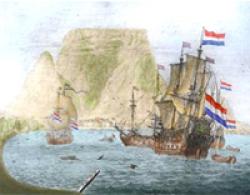
Published date
13 April 1688
The first Huguenots arrived as early as 1671, when the first Huguenot refugee, Francois Villion (later Viljoen), arrived at the Cape. By 1692, a total of 201 French Huguenots had settled at the Cape of Good Hope.
The Huguenots were French Protestants who were members of the Calvinist Reformed Church that was established in 1550. From the mid 1500s until the mid 1600s, Huguenots were persecuted in France for their religious beliefs. Therefore, thousands of Huguenots fled to countries such as Switzerland, Germany, England, America, the Netherlands, Poland and South Africa, where they could enjoy religious freedom.
Simon van der Stel (Governor of the Cape) set aside land for Huguenot settlement in Franschhoek ('French corner') and Drakenstein (present day Paarl), and gave orders for the French to be interÂspersed with the other burghers. His reasoning for this integration was 'that they could learn our language and morals, and be integrated with the Dutch nation'. Today, many farms in these areas retain their French names.
The Dutch East India Company encouraged the Huguenots to immigrate to the Cape because they shared the same religious beliefs (Protestant), and also because most Huguenots were highly trained craftsmen or experienced farmers. Huguenots were particularly experienced in viticulture and oenology (the growing of grapes and making of wine, brandy and vinegar). The Huguenots quickly proved their conscientious and industrious nature, and their efforts led to a marked increase in the improvement of the quality of Cape wines.
The Huguenots played an integral part in the stabilisation of the free burgher population. This is because without a fatherÂland to return to, they were forced to take root or disappear. Religious persecution had also made them more determined and more prepared to overcome obstacles. Huguenot descendants went on to establish themselves in positions of leadership in Afrikaner society, despite the fact that they comprised a minority of the population. Today, some 40 Huguenot surnames survive.
The Huguenots made a difference to South African society in another respect. Previously, the shortÂage of European women prompted many men to take half-caste slaves as brides or misÂtresses. The Huguenots were generally already married, young, and fecund. Therefore, as girls in these families matured, men's stable liaisons with non-European women declined, and a clearer pattern of endogamy was established.
References
UNHCR, (2013), ‘Chronology for Europeans in South Africa’, 12 March, [online], available at www.unhcr.org (Accessed: 12 March 2013)|
Wallis, F. (2000). Nuusdagboek: feite en fratse oor 1000 jaar, Kaapstad: Human & Rousseau.|
Coetzee, P. (2008), ‘The arrival and establishment of the Huguenots at the Cape of Good Hope’, from Huguenot Society of South Africa, 7 May, [online], available at www.hugenoot.org.za (Accessed: 12 March 2013)|
The contribution of the Huguenots in South Africa [online], available at: geocities.com (last accessed 12 March 2013)|
Giliomee et al. (2007), New History of South Africa. Tafelberg Publishers: Cape Town. Pg 60.